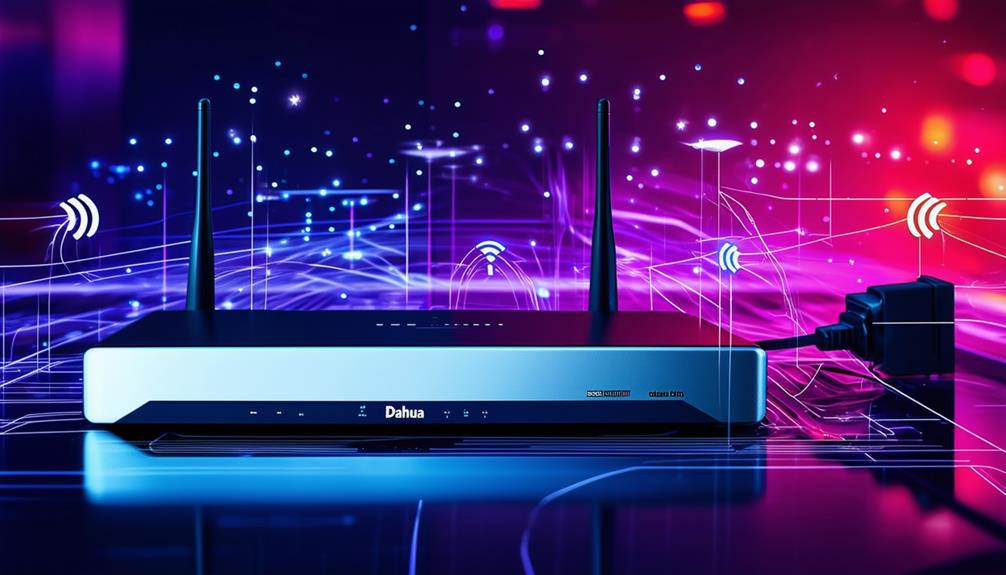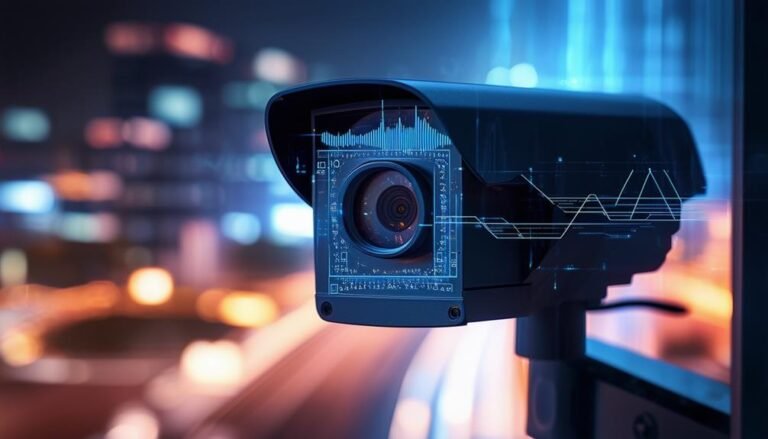To connect your Dahua NVR to WiFi, start by ensuring it’s powered on and within range of your router. Access the NVR’s main menu and go to “Network” settings. Select the “WiFi” option, then choose your WiFi network from the list, or manually enter its name. Input the correct WiFi password and hit “Connect.” After that, verify the connection by checking if you can access camera feeds. If you run into issues, make sure all settings are correct and consider troubleshooting the signal strength. Keep exploring for tips on securing your connection and ensuring reliability.
Understanding Dahua NVR Features
When you’re considering a Dahua NVR, it is essential to understand its key features to make the most of your investment. One standout feature is its ability to support multiple camera channels. This means you can monitor various areas simultaneously, giving you the freedom to keep an eye on your property like never before.
Another significant aspect is the user-friendly interface. You won’t have to be a tech wizard to navigate through settings and features. Whether you’re setting up recording schedules or adjusting camera views, its intuitive design empowers you to manage security effortlessly.
Storage options are also worth highlighting. Dahua NVRs typically support large hard drives, allowing for extensive video storage. You can choose how long you want to keep footage, ensuring that you have access to past incidents without worrying about running out of space.
Moreover, many Dahua NVRs come with built-in analytics features. This means you can set up motion detection alerts or receive notifications for unusual activity, giving you peace of mind whether you’re at home or away.
Lastly, consider the remote access capabilities. You can connect to your NVR from anywhere using a smartphone or tablet, making it easy to check in on your security system whenever you want. All these features combined provide you with robust security solutions, ensuring that your investment truly works for you and your freedom to explore the world without worry.
Preparing for WiFi Connection
To successfully connect your Dahua NVR to WiFi, you’ll need to take a few important steps. First off, make certain you have everything ready to go. This means gathering the necessary equipment and information. A little preparation can save you a lot of hassle down the road.
Here’s what you should have on hand:
- WiFi Network Name (SSID): Know your network’s name so you can find it easily when connecting.
- WiFi Password: Keep your password handy; you’ll need it to establish the connection securely.
- Dahua NVR Manual: Having the manual nearby can provide you with model-specific instructions that might come in handy.
Next, make sure that your Dahua NVR is powered on and within range of your WiFi router. If possible, place it closer to the router during the setup process. This will help you avoid any connection issues that might arise from a weak signal.
Lastly, double-check that your router is functioning correctly. You don’t want to run into problems during the connection process because of router issues. By taking these preparatory steps, you’re setting yourself up for a smoother experience when it comes time to access your NVR’s interface. Freedom in surveillance starts with a solid WiFi connection, so let’s get ready to make it happen!
Accessing the NVR Interface
To access your Dahua NVR interface, you’ll need to know its default IP address, which is essential for connecting to it. Once you enter the IP address in your browser, you’ll be prompted for your user login credentials. Make sure you have these details handy to get started.
NVR Default IP Address
Accessing your Dahua NVR interface requires knowing its default IP address, which is essential for configuring your network settings. Typically, the default IP address is set to 192.168.1.108. By entering this address into your web browser, you can access the NVR interface and start customizing your setup.
To make things easier, keep these points in mind:
- Check your network configuration: Verify your computer is on the same subnet as the NVR.
- Use a static IP address: If you’re experiencing connection issues, consider assigning a static IP to your NVR.
- Reset if necessary: If you can’t connect, a factory reset may restore the default IP address.
Once you’ve entered the default IP address, you’ll be able to adjust settings, connect to Wi-Fi, and manage your surveillance system freely. Remember, having the right IP address is just the first step toward revealing the full potential of your Dahua NVR. Embrace the power of knowing your setup, and enjoy the freedom that comes with a well-configured surveillance system.
User Login Credentials
Once you’ve entered the Dahua NVR’s default IP address, you’ll need to log in using the correct user credentials to access the interface. This step is essential for taking control of your surveillance system. The default username is typically “admin,” and the password is often “admin” or “123456.” However, if you’ve changed these credentials for security reasons, make sure you remember your custom login information.
If you’ve forgotten your password, don’t panic. Many Dahua NVRs have a password recovery option, or you can reset the device to factory settings, keeping in mind that this will erase all current configurations.
Once you’ve successfully logged in, you’ll have the freedom to customize your settings, view live feeds, and manage recorded footage. Steering through the interface may feel overwhelming at first, but with a little exploration, you’ll find it intuitive. Remember, protecting your system starts with a strong password, so consider updating your credentials to something unique and secure. This way, you’ll guarantee peace of mind as you manage your surveillance needs effectively. Take the reins and enjoy the control you have over your security system!
Configuring Network Settings
Configuring network settings on your Dahua NVR is essential for establishing a reliable connection to your WiFi network. This step guarantees that your device can communicate effectively, allowing you to access your security camera feeds without interruption. Start by directing yourself to the network settings menu on your NVR. Here, you’ll find options that allow you to set up your network connection.
To maximize your NVR’s performance and security, keep these key points in mind:
- IP Addressing: Make sure your NVR is set to use a static IP address. This prevents it from changing over time, which can disrupt your connection.
- Subnet Mask: This should typically be set to match your network’s configuration, usually 255.255.255.0 for home networks.
- Gateway: Enter the gateway address of your router, which allows your NVR to communicate beyond its local network.
Once you’ve entered this information, double-check everything to avoid any mistakes. An incorrect setting can lead to connectivity issues. After confirming your entries, save the changes and reboot the NVR if necessary. This guarantees that all new settings take effect properly.
Connecting to WiFi
With your network settings properly configured, you can now connect your Dahua NVR to your WiFi network. Start by accessing the NVR’s main menu using your mouse or remote control. Navigate to the “Network” settings, where you’ll find options for both wired and wireless connections. Since you’re aiming for wireless freedom, select the “WiFi” option.
You’ll see a list of available WiFi networks. Locate your network from the list, and click on it. If your network isn’t showing up, it might be due to a weak signal or a hidden SSID. In that case, you can manually enter your network name and details. After selecting your network, you’ll need to input your WiFi password. Make sure to enter it correctly, as it’s case-sensitive.
Once you’ve entered your password, hit “Connect.” The NVR will attempt to establish a connection to your WiFi network. Keep an eye on the status; if it connects successfully, you’ll see a confirmation message. If it doesn’t, double-check your settings and password.
Testing the Connection
After connecting your Dahua NVR to WiFi, it’s important to test the connection to verify everything’s working properly. After all, you want to guarantee that your security system is fully operational and that you’re able to access your cameras without a hitch. Here’s how you can do that.
First, take a moment to access the Dahua NVR interface through your web browser or the dedicated app. Log in using your credentials, and navigate to the network settings. You should see a status indicator that tells you whether the NVR is connected to WiFi. If it’s not showing connected, you’ll need to revisit your connection settings.
Next, try accessing your camera feeds. Open the live view option to see if you can stream video from your cameras. This step is essential because it confirms that your NVR can communicate effectively with your network.
Finally, consider running a speed test on your network to make sure the connection is robust enough for your needs. A strong connection is critical for reliable surveillance.
- Verify the connection status in the NVR settings.
- Access live camera feeds to check streaming.
- Conduct a speed test to guarantee network strength.
Troubleshooting Common Issues
When you encounter problems connecting your Dahua NVR to WiFi, troubleshooting effectively can save you time and frustration. First, double-check your WiFi settings. Confirm you’re using the correct SSID and password. It’s easy to mistype a letter or number, so take a moment to verify that everything matches perfectly.
If you’re still having trouble, check the signal strength. If your NVR is too far from the router, it might struggle to maintain a stable connection. Consider moving the NVR closer to the router or using a WiFi extender to boost the signal.
Another common issue is firmware compatibility. Make certain your NVR’s firmware is up to date. Outdated firmware can lead to connectivity problems, so it’s wise to visit the Dahua website and download the latest version if needed.
Don’t forget to look at network configurations, too. If your router has MAC address filtering enabled, you’ll need to add your NVR’s MAC address to the allowed list. This step can often be overlooked but is essential for a successful connection.
Lastly, if everything else fails, try rebooting both your NVR and router. Sometimes, a simple restart can resolve connectivity issues that feel impossible to fix. By systematically checking these aspects, you’ll likely pinpoint the problem and get your Dahua NVR connected to WiFi smoothly. Enjoy the freedom of surveillance anywhere in your home!
Securing Your WiFi Connection
Securing your WiFi connection is essential for protecting your Dahua NVR and the sensitive data it handles. A weak or unsecured network can leave your devices vulnerable to unauthorized access and cyber threats. By taking a few simple steps, you can enhance your security and enjoy peace of mind while using your NVR.
First, make sure you’ve set a strong password for your WiFi network. Use a mix of upper and lower case letters, numbers, and special characters to create a password that’s hard to guess. Next, consider changing the default SSID (network name) to something unique. This can make it harder for potential intruders to identify your network. Finally, enable WPA3 encryption if your router supports it, as it provides the strongest protection available.
Here are some key actions you should take:
- Use a strong, unique password for your WiFi network.
- Change the default SSID to a custom name.
- Enable WPA3 encryption for enhanced security.
Frequently Asked Questions
Can I Connect Multiple Dahua NVRS to the Same Wifi Network?
Yes, you can connect multiple Dahua NVRs to the same Wi-Fi network. It’s a great way to expand your surveillance capabilities without being restricted. Just make sure your Wi-Fi network can handle the additional devices and that you properly configure each NVR with unique IP addresses. This way, you’ll have the freedom to monitor various locations simultaneously, ensuring you’re always in control of your security setup. Enjoy the flexibility!
What Is the Maximum Distance for a Stable Wifi Connection?
The maximum distance for a stable Wi-Fi connection really depends on various factors, like the router’s power, the environment, and any obstacles in the way. Generally, you can expect a reliable connection up to about 150 feet indoors and up to 300 feet outdoors. If you’re looking for freedom in your setup, consider minimizing obstructions and placing your router in a central location to optimize that range.
How Do I Reset My Dahua NVR to Factory Settings?
To reset your Dahua NVR to factory settings, start by accessing the main menu. Navigate to the “Settings” option, then look for “Default” or “Factory Reset.” Once you find it, confirm your choice to reset. Keep in mind that this process erases any custom settings, so make sure you’ve backed up important configurations. After the reset, you’ll regain full control over your device, allowing you to set it up anew for your needs.
Will Connecting to Wifi Affect My Video Recording Quality?
Connecting to WiFi shouldn’t directly affect your video recording quality, as recordings are typically saved locally on the NVR. However, if your NVR relies on WiFi for accessing remote storage or streaming, a weak connection could lead to delays or interruptions. To guarantee your recordings remain reliable, consider using a wired connection whenever possible. This way, you can enjoy the freedom of remote access without compromising on video quality.
Can I Use a Wifi Extender With My Dahua NVR?
Yes, you can use a WiFi extender with your Dahua NVR. It’ll help boost your signal strength, especially if you’re trying to reach a distant area. Just make sure the extender is compatible with your router and the NVR. Once it’s set up, you should notice an improvement in your connection stability. This way, you can enjoy seamless video streaming and recording without worrying about weak signals disrupting your surveillance system.



